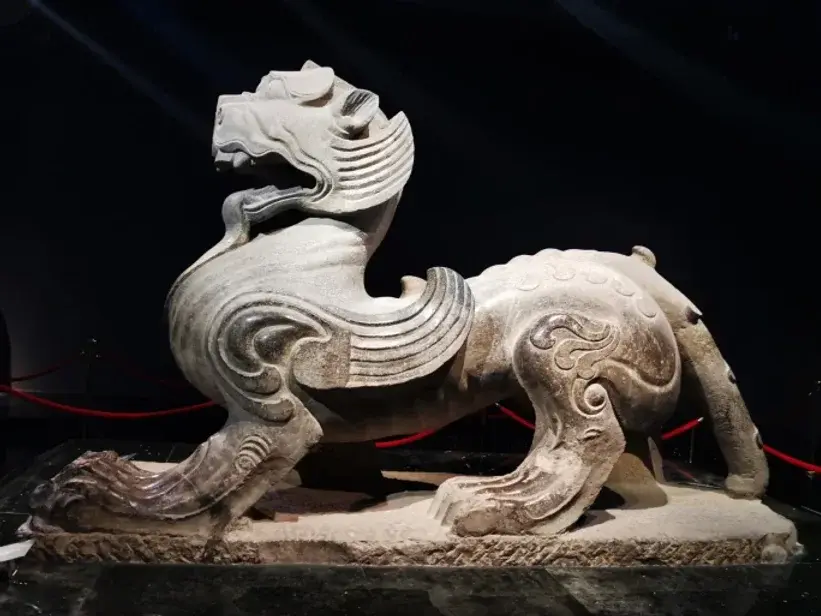這類青銅辟邪在早期的文獻中被推定為六朝時期的作品,與南朝時期在通往王公陵墓的「神道」上成對豎立的巨型有翼神獸石雕相類似,但最近的學術研究已達成共識,認為這類青銅辟邪應屬於漢代。
在漢代的中國意象中,有翼獅子獸的基本形態已經確立,而使用青銅辟邪作為墊重也是漢代家具中熟悉的元素。
Bronze bixie of this type have been dated to the Six Dynasties period in earlier publications, by analogy with the massive stone sculptures of winged feline beasts which were erected in pairs on the "spirit roads" leading to princely tombs of the Southern Dynasties, but more recent scholarship has led to a consensus in favor of an attribution to the Han dynasty.
The basic form of a winged feline guardian beast is well established in Chinese imagery of the Han dynasty, and the use of bronze coiled animals as mat weights is a familiar element in Han tomb furniture.
PROVENANCE
To 1961J. T. Tai & Co., New York, New York. [1]
From 1961Freer Gallery of Art, purchased from J. T. Tai & Co., New York, New York. [2]
PREVIOUS OWNER(S) AND CUSTODIAN(S)
J.T. Tai & Co. established in 1950
PUBLISHED REFERENCES
Masterpieces of Chinese and Japanese Art: Freer Gallery of Art handbook. Washington, 1976. p. 21.
HISTORICAL PERIOD(S)
Eastern Han dynasty, ca. 1st-2nd century
DIMENSIONS
H x W x D: 19.3 x 36.6 x 13.7 cm (7 5/8 x 14 7/16 x 5 3/8 in)
ACCESSION NUMBER
F1961.3
戴潤齋是誰?
Who is J.T.Tai
這件作品來自戴潤齋的收藏,同樣來自J.T.Tai的著名青銅器還有舊金山亞洲藝術博物館收藏的存世孤品:商代犀尊,詳細參考SACA學會發表的:
▲ 戴润斋 (J.T. Tai),1920年代末在家乡无锡舅父秦叔开设的古董店当学徒。 凭借天赋、上好的眼力和敏锐的生意头脑,很快就被委任买手的任务。1930年代移居上海,开设个人古董店,1949年移居香港,从此没有返回祖国。1950年,移居美国,1953年首次赴英法便在著名的克拉克夫人明代专场购得11件拍品。1960-70年代,活跃于世界拍场,并与布伦戴奇、塞克勒关系密切。
▲ 「小臣艅」尊,清道光时期山东寿张梁山(今山东梁山县)出土,商代晚期,青铜,长 32.8 厘米,宽 22.9 厘米,高 22.9 厘米,美国旧金山亚洲艺术博物馆藏(B60B1+)
從這兩件精美的藏品不難推測出戴潤齋在60年代美國的眼光和影響力,特別是在對頂級藝術品的理解上,具有不亞於山中商會、盧芹齋的能量。
藍理捷 J.J.Lally
一、鎏金辟邪 (大都會博物館)
Provenance
Collection of Mr. and Mrs. Richard C. Bull, acquired from Mathias Komor Gallery, New York, early 1950s
Sotheby Parke Bernet, New York, Important Chinese Works of Art: the Collection of Mr. and Mrs. Richard C. Bull, 6 December 1983, lot 59
二、漢辟邪銅鎮 2006年展覽
AN ARCHAIC BRONZE BIXIE-FORM MAT WEIGHT
Han Dynasty (206 B.C. – A.D. 220)
Height 3 1⁄2 inches (8.9 cm)
這件獨立式的神獸在厚厚的圓形雲紋底座上大步前進,圓形浮雕上有螺旋點,形成不規則的鏤空邊緣,圍繞著緊緊捲曲的貓科動物的身體,短翼從肩部向後彎曲。
長尾從多節脊骨的末端向下延伸、 高高昂起的頭以挑釁的姿態,兩隻長角從額頭向後捲曲,背後是深陷眼窩的大眼睛,張開的嘴露出尖利的獠牙和捲曲的舌頭,尖尖的胡鬚從下巴垂下、 圓形底座的平底圍繞著一圈圓形的螭紋。
圓形底座的平底圍繞著一個厚重的核心,並顯示出銅釘的末端從辟邪的腳底向下延伸,以固定在灌滿鉛的底座上。
the free-standing mythical beast shown striding on a thick circular base of swirling clouds in rounded relief with spiral points rising to form an irregular openwork border around the tightly coiled feline body of the bixie with short wings curling back from its shoulders and a long tail extending down from the end of its knobby ridged backbone.
Its head held high in a defiant attitude, with two long horns curling back from the forehead behind large staring eyes set in deep sockets, the mouth open showing sharp fangs and a curled tongue above a pointed beard hanging down from the chin, the jowls with tufts of fur projecting back under the pointed ears, the short powerful legs ending in paw feet with long claws, tramping over the separately cast body of a serpentine dragon shown curled under the bixie with its small head emerging in front of the bixie’s chest, as if struggling to escape.
The flat foot of the circular base enclosing a heavy core and showing the ends of bronze pegs extending down from the base of feet of the bixie for attachment to the lead-filled base with an attractive smooth pale green patina all over highlighted with widely scattered bright green encrustation, a fragment of ancient wood adhered to the flat base.
三、何鴻卿爵士青銅辟邪 蘇富比拍賣
何鴻卿爵士的這件辟邪與弗里爾的十分相似,但可以確認不是一對。背後多了一個插座,應該是一個構件的一部分。
這件作品一直被放在何鴻卿爵士的書桌上,中國古代當官靠的是科舉,是一套非常嚴謹的制度。書桌案頭便是與帝王相處之余的精神世界,以蘇軾為代表的文人,一直以來都有案頭賞玩的藝術品作為精神寄託,這套傳統被一直傳遞下來。這種傳統,甚至影響了帝王,比如乾隆皇帝。
何鴻卿爵士的案頭,便是一個中國傳統文人十分真實的寫照。
A Sir Joseph Hotung bronze 'bixie', attributed to the Han Dynasty, fetched HK$35,465,000 in October 2022, won by Daniel Eskenazi, a renowned antique dealer from London, UK.
The piece had been sitting on Sir Joseph's desk. In ancient China, officialdom was based on the imperial examinations, a very rigorous system. The desk was the spiritual world of the emperor, and the literati, represented by Su Shi, have always had artworks on their desks as their spiritual support, a tradition that has been passed on ever since. This tradition also influenced the emperors, such as the Qianlong Emperor.
The desk of Sir Joseph is a very realistic portrayal of a traditional Chinese literati.
四、克里夫蘭博物館(Eugene Bernat)
Provenance
?–1980 Mr. Eugene [1896–1982] and Mrs. Elva Bernat, consigned to Sotheby Parke-Bernet for sale
1980 (Sotheby Parke Bernet, Inc., New York, NY, sold to the Cleveland Museum of Art)
1980– The Cleveland Museum of Art, Cleveland, OH












































Comments